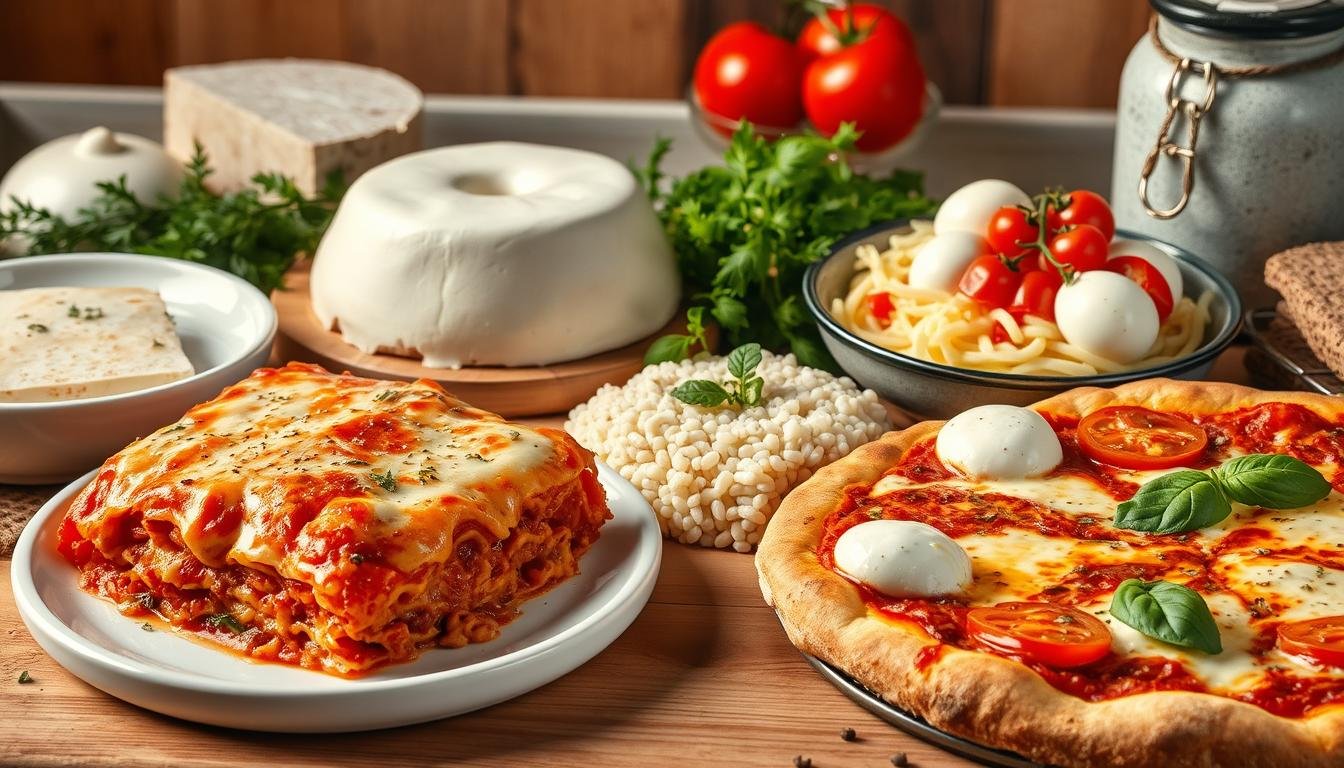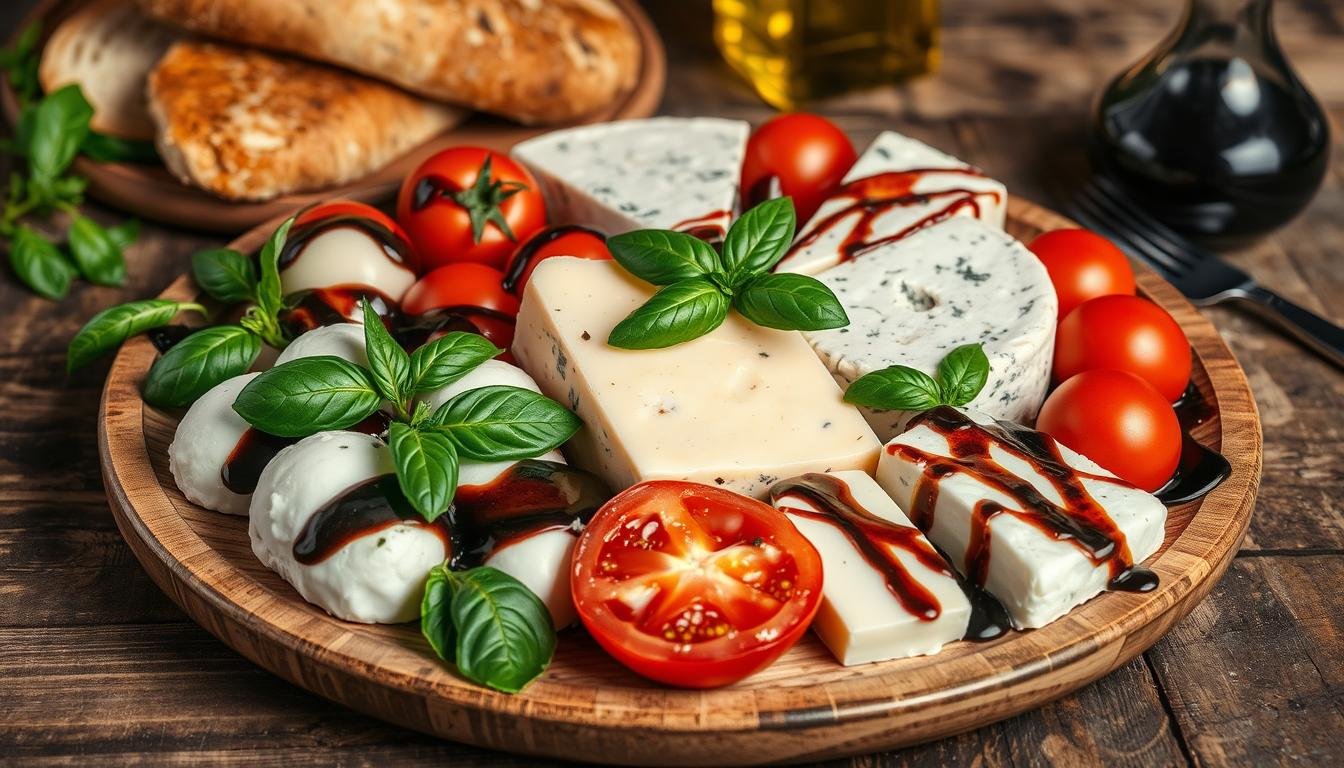Italy’s rich culinary heritage has won the hearts and taste buds of families globally. With over 19 different recipes, Italian meat dishes are incredibly diverse. Chicken dishes feature in 6 of these, while pork ribs are the star of the Sunday Sauce.
Ingredients like prosciutto, Italian sausage, and capers add unique flavours to beloved classics. This shows Italy’s dedication to creating hearty, comforting meals.
Key Takeaways
- Italy’s meat dishes feature a wide variety of proteins, including chicken, pork, beef, and Italian sausage.
- Iconic Italian ingredients like prosciutto, capers, and Grana Padano cheese are frequently used to enhance the flavour of meat-based recipes.
- Traditional techniques, such as slow cooking and grilling, are employed to bring out the best in Italian meat dishes.
- Homemade sauces, marinades, and seasonings play a crucial role in the authenticity of Italian meat recipes.
- Italian meat dishes are deeply rooted in family traditions and regional specialties, showcasing the country’s diverse culinary heritage.
Introduction to Italian Meat Dishes
Meat is a big deal in Italian food, with lots of beef, pork, and lamb dishes loved everywhere. Each area in Italy has its own special meat dishes. These show how versatile and tasty these meats can be.
The Importance of Meat in Italian Cuisine
In Italy, meat is more than food. It’s a way to bring families and friends together. The smell of ragù sauce or bistecca alla fiorentina can make people remember happy times and get excited.
Key Ingredients in Italian Meat Recipes
- High-quality olive oil
- Fresh herbs like rosemary, basil, and oregano
- Garlic, onions, and other aromatic vegetables
- Regional cheeses like Parmigiano-Reggiano, Pecorino Romano, and Gorgonzola
These key ingredients, mixed with old cooking ways, make Italian beef dishes, pork dishes, and lamb dishes famous all over.
“Italian cuisine is a symphony of simple, high-quality ingredients that come together to create something truly extraordinary.”
Classic Italian Meat Dishes
Italy is famous for its hearty meat dishes loved worldwide. From Milan’s Osso Buco to Rome’s Saltimbocca alla Romana, these recipes highlight Italy’s meaty cuisine. Let’s dive into these family-favourite dishes that have lasted through time.
Osso Buco: A Milanese Masterpiece
Osso Buco comes from Milan and has won the hearts of many. It’s made with braised veal shanks in a wine sauce, with veggies and herbs. This dish shows how meat-based sauces and rustic flavors make Italian cooking special.
Saltimbocca alla Romana: A Roman Delight
Saltimbocca alla Romana is from Rome and shows the city’s cooking skill. Thin veal cutlets are topped with prosciutto and sage, then pan-fried. It’s a perfect mix of flavors and textures, showing Italy’s love for simple, yet satisfying, meat dishes.
Bolognese Sauce: A Heartwarming Tradition
The Bolognese sauce is a must-mention in Italian meat dishes. From Bologna, it’s simmered for hours with ground beef, pancetta, and veggies. Over pasta, it’s the essence of Italian home cooking.
These dishes, each with its own twist, show Italy’s rich meat heritage. Whether you prefer Osso Buco, Saltimbocca, or Bolognese, these classics will always satisfy.

Meat-Based Regional Specialties
Italy’s diverse regional cuisines show the country’s rich culinary heritage. Each area has its own signature meat-based dishes. Two such specialties are Brasato al Barolo from Piedmont and Porchetta from central Italy.
Brasato al Barolo: A Piedmontese Favourite
In Piedmont, the dish Brasato al Barolo is famous. It features tender beef braised in Barolo wine. This slow-cooked dish lets the Barolo’s full-bodied flavour infuse the meat.
The long cooking process makes the beef soft. It’s a treasured regional specialty.
Porchetta: The Celebratory Roast of Central Italy
Traveling south to central Italy, you find Porchetta. It’s a whole roasted pig seasoned with herbs, garlic, and spices. This dish is a celebration of pork and slow-roasting.
The result is a succulent, flavourful roast. It’s often served in wedges, on its own or with other dishes.
These regional meat-based specialties highlight Italy’s culinary diversity. They use local ingredients and cooking methods passed down through generations. They show the richness and variety of Italian cuisine, loved by food enthusiasts worldwide.
Pasta Dishes Featuring Meat
Italian cuisine loves pasta dishes with meat. Classics like lasagna and fettuccine Alfredo with chicken are favourites everywhere. These meals are hearty and loved by many.
Lasagna with Rich Meat Ragu
Lasagna is a layered pasta dish with a rich meat ragu. This sauce is made from ground beef or pork, tomatoes, and herbs. It’s a perfect match for pasta and cheese, making a comforting dish.
Fettuccine Alfredo with Grilled Chicken
Fettuccine Alfredo is often made with grilled chicken. The creamy sauce and tender chicken create a delicious mix. It’s a satisfying dish for all.
Meat in pasta dishes shows how versatile Italian cuisine is. It combines meat with pasta, making tasty meals loved by families globally.

Meat and Cheese Pairings
In Italian cuisine, pairing meats and cheeses is key to a great meal. From prosciutto and melon to salami and Parmigiano-Reggiano, these combos show how well Italian cheese and cured meats work together.
The Art of Pairing Italian Meats and Cheeses
Italian charcuterie boards offer endless pairing options. Burrata or mozzarella’s creaminess pairs well with prosciutto’s saltiness. Parmigiano-Reggiano’s sharpness goes great with coppa or mortadella. And, prosciutto and melon is a classic sweet and salty mix.
| Italian Meat | Complementary Cheeses |
|---|---|
| Prosciutto | Fresh mozzarella, burrata |
| Salami | Aged gouda, sharp cheddar |
| Mortadella | Parmigiano-Reggiano, pecorino, gorgonzola |
| Coppa | Aged parmesan, sharp pecorino, creamy gorgonzola |
| Bresaola | Fresh mozzarella, creamy brie, mild goat cheese |
Pairing Italian cured meats with cheeses like mozzarella or gorgonzola makes for a tasty experience. It’s perfect for enjoying with loved ones.
Popular Italian Meat Cooking Techniques
Italian cuisine is famous for its tasty meat dishes. The cooking methods used are key to this heritage. From slow cooking to grilling, these techniques have been honed over generations. They bring out the best in the ingredients.
Slow Cooking: Enhancing Flavors Through Time
Slow cooking, or cottura a lungo, is a core technique in Italian meat dishes. It lets flavors meld over time. This makes tough meat tender and adds deep, rich flavors.
Dishes like osso buco and brasato al Barolo show slow cooking’s magic. The meat becomes so tender it falls off the bone. The sauces become velvety and rich.
Grilling: The Italian Love for Fire-Cooked Meat
Grilling, or alla griglia, is a favorite in Italian cooking, perfect for steaks and chops. The Florentine beefsteak, or Bistecca alla Fiorentina, is a top example. It highlights the beauty of simple, quality ingredients.
The high heat sears the outside, creating a delicious char. Inside, the meat stays juicy and tender. This lets the meat’s natural flavors stand out.
| Cooking Technique | Dishes | Key Characteristics |
|---|---|---|
| Slow Cooking | Osso Buco, Brasato al Barolo | Tenderizes tough cuts, infuses deep flavors |
| Grilling | Bistecca alla Fiorentina | Creates a delectable char, retains juiciness |
These cooking methods are central to Italian cuisine’s rich heritage. They show Italy’s culinary skill and love for cooking techniques.

Italian Meat Marinades and Seasonings
Italian meat dishes get their rich flavors from marinades and herbs. Marinades mix olive oil, garlic, and herbs like rosemary and thyme. They make the meat tender and taste amazing.
Traditional Marinades for Meat Dishes
Italian cuisine is known for simple, yet powerful, marinades. A classic marinade might include:
- Olive oil
- Fresh garlic, minced
- Fresh rosemary, finely chopped
- Fresh thyme, finely chopped
- Lemon juice or red wine vinegar
- Salt and freshly ground black pepper
The meat soaks in this marinade for at least a day. Some recipes suggest up to 2-3 days for better flavor and tenderness.
Italian Herbs and Spices: Elevating Flavour
Italian herbs and spices make meat dishes special. Common ones are:
- Basil: Adds a sweet, peppery taste
- Oregano: Brings a warm, earthy flavor
- Parsley: Adds a fresh, herbaceous note
- Fennel seeds: Give a licorice-like taste
The mix and amount of these Italian herbs change with each dish. This creates unique seasoning techniques that make Italian food so rich and complex.

“The judicious use of herbs and spices is what truly elevates Italian meat dishes from the ordinary to the extraordinary.”
| Herb/Spice | Flavor Profile | Common Uses |
|---|---|---|
| Basil | Sweet, slightly peppery | Tomato-based sauces, pesto, grilled meats |
| Oregano | Warm, earthy | Pizza, pasta dishes, roasted meats |
| Parsley | Bright, herbaceous | Garnishes, sauces, marinades |
| Fennel Seeds | Licorice-like | Sausages, roasted vegetables, braises |
Homemade Italian Meat Sauces
Homemade meat sauces are the heart of classic Italian cuisine. They include beloved meatballs, or polpette, and the rich ragu sauce. These dishes bring authentic Italian tastes to your table.
Preparing Authentic Italian Meatballs
Italian meatballs mix ground beef, pork, or veal with breadcrumbs, cheese, and herbs. It’s important to handle the mixture gently. This ensures the meatballs are tender and juicy.
A pinch of red pepper flakes adds a subtle spice. You can adjust the amount to your liking.
Crafting a Homemade Ragu Sauce
The ragu sauce is a meat-based sauce essential in Italian cuisine. It’s made by slow-simmering vegetables, tomatoes, and ground meat. The long cooking time enhances the flavours, making the sauce rich and velvety.
Whether making polpette or ragu, these sauces are key to many pasta dishes. Preparing them from scratch brings authentic Italian tastes into your kitchen.
| Sauce | Key Ingredients | Typical Uses |
|---|---|---|
| Ragu | Ground beef, pork, or a blend, sautéed vegetables, tomatoes, wine, broth, milk | Served with wide pasta like tagliatelle or lasagna |
| Ragu alla Bolognese | Ground beef, pork, or veal, less tomatoes, white wine | Traditionally served with wide pasta or lasagna |
| Ragu alla Napoletana | Ground beef, pork, or lamb, more tomatoes, red wine | Traditionally served with thin pasta like spaghetti |
| Pomodoro Sauce | Tomatoes, garlic, basil, olive oil | Ideal for spaghetti |
| Marinara Sauce | Tomatoes, garlic, herbs, olive oil | Versatile for pasta, pizza, and more |

Vegetarian Alternatives to Meat Dishes
Meat is a big part of traditional Italian food, but there are many tasty vegetarian options. These include plant-based versions of classic dishes and new recipes with tofu and seitan. Italian vegetarian cooking offers a wide range of flavours and textures.
Plant-Based Takes on Italian Classics
Meatballs, a favourite in Italy, can be made with lentils or mushrooms for a meaty alternative. Tofu or seitan can replace chicken or veal in dishes like Chicken Parmesan or Veal Scaloppini. This lets vegetarians enjoy the flavours of traditional Italian food.
Using Tofu and Seitan in Traditional Recipes
Tofu and seitan are great for adding protein to Italian dishes. Tofu can be marinated and grilled like meat in Eggplant Rollatini. Seitan makes hearty dishes like Vegan Meatballs in Tomato Sauce.
“The key to successful vegetarian Italian cooking is to focus on bold, authentic flavours. By using high-quality ingredients and techniques like slow-cooking and grilling, you can create meatless dishes that are just as satisfying as their meat-based counterparts.”
Exploring vegetarian Italian cuisine is a culinary adventure. It’s perfect for vegetarians or anyone wanting to eat more plant-based. Reimagining classic Italian dishes opens up endless possibilities.

| Vegetarian Italian Dish | Average Star Rating | Number of Ratings |
|---|---|---|
| Gluten-Free Spaghetti | 5.0 | 83 |
| Courgette & Ricotta Lasagne | 4.8 | 696 |
| Creamy Mushroom Tagliatelle | 4.6 | 124 |
| Vegan Eggplant Parmesan | 4.4 | 56 |
| Italian-Style Veggie Dumplings | 0.0 | 2 |
Family Traditions and Meat Dishes
In Italian homes, meat dishes are a big part of family traditions and celebrations. Sundays often bring slow-cooked delights like brasato al Barolo and osso buco from Milan. Each family has its own twist on these classics, adding their own flavours and cooking methods.
How Italian Families Celebrate with Meat
Preparing and sharing meat meals is a big part of Italian family life. From nonna recipes to new twists, these traditions are a big part of Italy’s food history. Cooking together brings warmth, nostalgia, and closeness to the family.
Recipes Handed Down Through Generations
- Classic Bolognese sauce, a comforting blend of slow-cooked minced meat, tomatoes, and aromatic herbs
- Saltimbocca alla Romana, a Roman delight featuring tender veal topped with prosciutto and sage
- Porchetta, the celebratory roast pork dish found throughout central Italy
These treasured recipes tell stories and connect families. They keep Italy’s meat traditions alive, bringing generations together.

“Meat dishes are the heart and soul of Italian family gatherings. They’re not just about the food, but about the memories, the laughter, and the love that are shared around the table.”
Dessert Pairings for Italian Meat Meals
Ending an Italian meal with a sweet treat is perfect. It balances the flavours of meat dishes, making the meal complete. A sweet dessert is just what you need after a savoury meal.
Sweet Breads and Cakes: The Perfect Ending
Italian desserts like panettone and pandoro are great for special occasions. They’re light and buttery, matching well with meat dishes. These sweet breads offer a comforting finish to your meal.
Traditional Tiramisu: A Classic Italian Dessert
Tiramisu is another classic Italian dessert that goes well with meat. It’s made with coffee, creamy mascarpone, and cocoa powder. This dessert contrasts nicely with the savoury meat, ending your meal on a high note.
| Italian Dessert | Pairing with Meat Dishes |
|---|---|
| Panettone | The light, buttery texture of panettone complements the robust flavours of Italian meat dishes, offering a comforting and satisfying end to the meal. |
| Tiramisu | The coffee-flavoured tiramisu provides a delightful contrast to the savoury notes of Italian meat dishes, creating a harmonious conclusion to the dining experience. |

Whether it’s a sweet bread, creamy tiramisu, or another Italian dessert, they’re all great with meat dishes. These treats make your meal complete and satisfying.
Conclusion: Enjoying Italian Meat Dishes at Home
Bringing Italy’s famous meat dishes into your kitchen is rewarding. Use top-notch ingredients and traditional methods to capture Italy’s essence. Try making Osso Buco, Saltimbocca, or Bolognese sauce to connect with Italy’s food heritage.
Tips for Hosting an Italian-Themed Dinner
For an Italian-themed dinner, create a welcoming space that matches the food’s flavours. Serve Italian wines with your meat dishes and add antipasti or salads for balance. Use linen, terracotta, and soft lights to make your guests feel like they’re in Italy.
Final Thoughts on Family-Favourite Recipes
Italian meat dishes are loved for their comforting tastes and rich traditions. They bring families together, whether it’s a Sunday dinner or a special event. These recipes let you celebrate Italian cooking and make memories with your loved ones.





